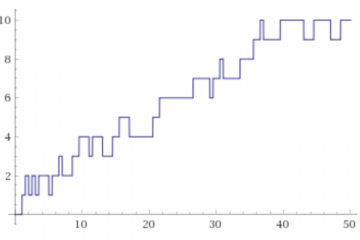Problem
There are four people A, B, C, D. A box with a red ball inside it is given to A, who can leave things unchanged with probability \(p\) or replace the red ball with a white one with probability \(q=1-p\). The box is passed to B who can leave the box unchanged with probability \(p\), or change the color of the ball from red to white or vice versa. Then it is the turn of C and then of D, with the same modalities and probability.
At the end a check is made and there is a red ball in the box.
What is the probability that A originally left the red ball?
Other equivalent formulations of the problem can be given. For example, this one: there are four people A, B, C, D who tell the truth with probability \(p\). Initially A makes a statement; so D says that C says that B says that A has told the truth. Compute the probability that A has told the truth.
For the solution of this exercise it’s necessary to know some elementary concepts of Theory of Probability. For an introduction to Probability with numerous exercises performed, see for example [1].
Solution
We define the following events:
- \(X\): A left the red ball in the box
- \(Y\): at the end there is a red ball in the box
- \(X \cap Y\): intersection event, that is true if \(X\) and \(Y\) are both true
To solve the problem we have to compute the following conditional probability:
\[ P(X|Y)= \frac {P(X \cap Y)}{P(Y)} \]where the symbol \( P(X|Y)\) indicates the probability that \(X\) is true, given the knowledge that the event \(Y\) has occurred.
1) Calculation of \(P(Y)\)
There must have been an even number of color changes, since the ball was initially red. Three cases are possible with the following probabilities:
- 0 changes \(p_{1}= p^4\)
- 2 changes \(p_{2}= {\binom{4}{2}}p^2q^2\)
- 4 changes \(p_{3}= q^4\)
Then we have:
\[ P(Y) = p_{1} + p_{2} + p_{3}=p^4 + {\binom{4}{2}}p^2q^2 + q^4 \]2) Calculation of \( P (X \cap Y)\)
Even in this case there must have been an even number of color changes. However, A has made no changes if it is true the event \(X\). So we only have these two cases, with the following probabilities:
- 0 changes \(p_{1}= p^4\)
- 2 changes \(p_{2}= {\binom{3}{2}}p^2q^2\)
Then we have
\[ P(X \cap Y) = p_{1} + p_{2}= p^4 + {\binom{3}{2}}p^2q^2 \]Putting together the two results we finally have:
\[ P(X|Y)= \frac {P(X \cap Y)}{P(Y)} = \frac {p^4 + {\binom{3}{2}}p^2q^2}{p^4 + {\binom{4}{2}}p^2q^2 + q^4} \]For example, if \(p=\frac{1}{3}\) the probability is \(P(X|Y)= \frac{13}{41} \).
If \( p=\frac{1}{2}\) the probability is \( P(X|Y)= \frac{1}{2}\), as was to be expected for reasons of symmetry.
Bibliography
[1]Murray Spiegel – Probability and Statistics (McGraw-Hill)


0 Comments